17 Types of Lantana for Perennial Colors in Your Garden
Author: Jen Worst | Editor: Omar Alonso
Review & Research: Jen Worst & Chris Miller

Cultivating various types of lantana flowers in the garden is a wonderful way to add colors to your landscaping endeavors.
You are probably familiar with common flowers like roses, sunflowers, daisy, lilac, marigold, impatiens, and such, but have you ever wanted to add appealing perennial flower plants to your collection? Then try out the lantana, belonging to the Verbenaceae family.
Lantana flowering plants are adored by flower lovers because of their drought-tolerant capability, meaning they will last for years and years and continue to bloom colorful flowers. There is a catch, there are different types of lantana, and every variant has its characteristics. So how do you pick one?
This article should help you know more about lantana varieties and make things easy for you to decide what you want in your garden.
17 Types of Lantana
Lantana camara is classified in the family Verbenaceae, within the order Lamiales, within the class Magnoliopsida. It's an invasive plant that will quickly grow into dense thickets in areas it's not welcome in once it escapes domestic cultivation.
Not only are Lanterns eye-catching, but they also serve a bigger purpose when it comes to ecological importance. These flowers can help provide nectar for hummingbirds, bees, and butterflies.
That's not all, medicines are made from the lantana leaves and used as antiseptics and other health alleviating needs. If you plan to get hold of these pretty flowers for your garden, then you first need to know about their ranging varieties. Some of the common shrub types of verbena are given below.
Tropical Lantana
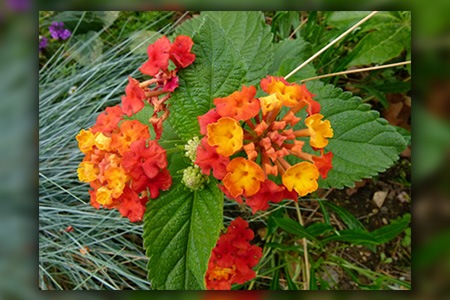
Also known as crimson lantana, this particular plant blooms vivid flowers during the late summer season. The flowers are crimson red, and they grow near one another.
The colorways can range from salmon pink, yellow to purple in some cases. Tropical lantana also produces red berries that can be a food source for mocking birds and other birds except for mammals.
This flowering plant can live and grow in shades, but it is best and most lively under full sun. It doesn't need much watering, therefore the maintenance is not a hassle.
Moreover, this lantana species is known to tackle hot climates without much fuss. Keep in mind that the newly put up trees (young ones) will need a bit of care and regular water to flourish. Plant them along side colorful types of camellias and you'll have something special going.
Mountain Lantana
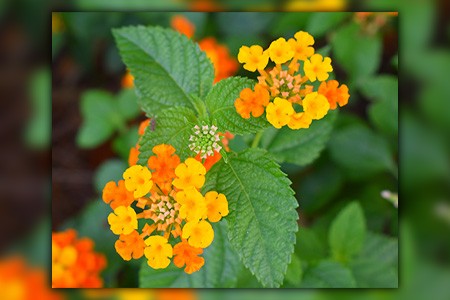
The mountain lantana is another common variant of flowering plants. This kind of plant grows large gleaming leaves on them topped with pinkish, yellowish, reddish flowers. The leaves on this lantana change color, it turns yellow during the fall season.
Similar to crimson lantana, mountain lantana needs very little care in its full bloom. Just light fertilization every 2 weeks until the spring season should work wonders.
Watering the plant regularly is not needed, as these types of lantana plants can live in a dry climate. Just make sure there is enough rainfall throughout the year. Letting these grow up alongside purple colored types of aster makes for a colorfully contrasting flowerbed.
Prairie Lantana
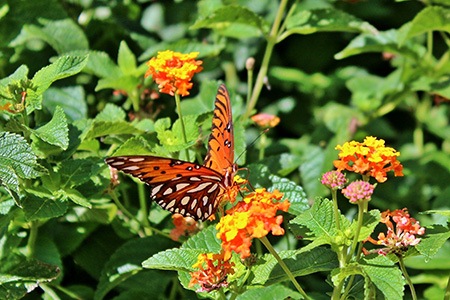
This is a kind of lantana plant that grows in grasslands such as prairies. Such plants are North American natives. It is not like regular lantana with blooming flowers. It does not produce flowers but rather grows runners from the underground stems.
When put beside other flowering plants, the prairie might produce flowers. It cultivates best in the ground with moist soil and adapts to full sunlight. Prairie Lantana is known to hold its ground even during cold breezes.
Dallas Red Lantana
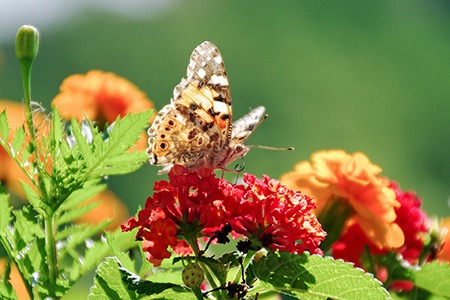
If you want a large lantana species that can attract plenty of pollinators, then look no further than the Dallas Red lantana varieties. They have a wonderful color palette that includes a dark orange at the center of the flower that then produces a bright red as it matures.
Due to how quickly they can grow and how they can adapt to many soil conditions, people enjoy them both in residential applications and commercial landscapes. They're good on hills to help reduce soil erosion.
They're drought resistant but that doesn't mean you won't notice the effects. The leaves of the flowers can drop off when there's little moisture, but you'll find they'll grow back fairly fast once watered again.
Evergreen Lantana
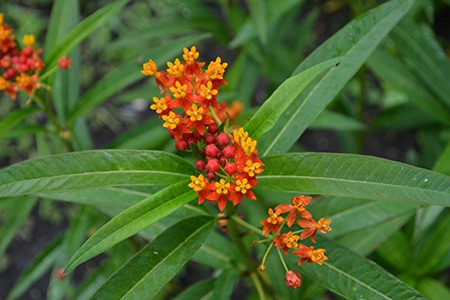
The name says it all, it is a flowering plant that is evergreen and never goes inactive. Although in a garden setup, you won't see flowers blooming throughout the season. During July, it is like to flaunt some dazzling colors of pink and yellow shades.
In winter, this plant keeps producing greens even if there is no flower. The fresh greens are always lush and beautiful. The darker green color looks good alongside the lighter green color of the various types of Bermuda grass, if that will thrive in your area.
Pumpkin Patch Lantana
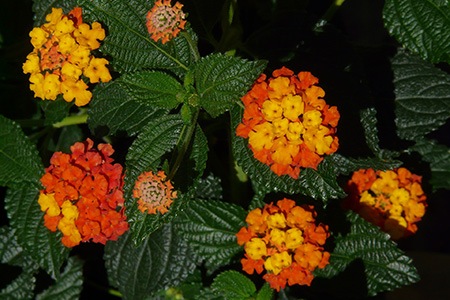
The pumpkin patch lantana flowers are orangish in color, similar to pumpkins, with greenish-yellow leaves. It is a kind of lantana that thrives in moist environments and therefore you should provide moist soil for it to grow effectively.
These types of lantana flowers also need direct sunlight exposure to keep growing and producing flowers. In cold temperatures, try to keep the plant at around 50°F to avoid damage.
Make sure to water the plant once a week, don't overflood it. The palace for Pumpkin Patch lantana is where there is plenty of sun exposure.
Hybrid Lantana
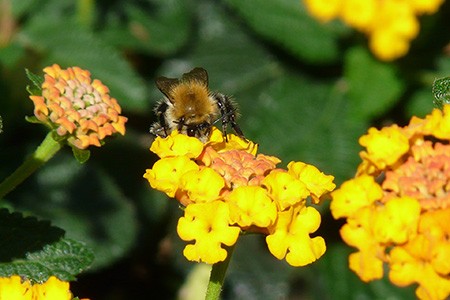
The hybrid lantana keeps producing flowers for a long season, especially during the warm months. It can last in partial shade but blooms effectively under direct sun. The hybrid is what the name suggests, it shares characteristics of many other kinds of lantanas.
Some hybrids can have longer leaves with few spikes, whereas others may have runners and no flowers. Hybrids are available in various selections and come in wide rays of colorways.
These plants are perennials in places where the cold is mild and annual where it's extremely chilly throughout the year.
Chapel Hill Yellow Lantana
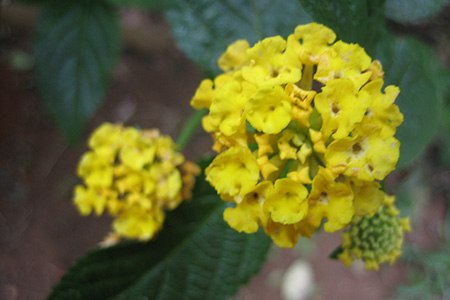
When looking for different lantana plants that only grow up to 1 to 2 feet in height, the Chapel Hill Yellow lantana is a hardy option. It'll grow out to 3 to 4 feet in width and produce dark green foliage which makes a wonderful backdrop for the bright yellow flowers and their sweet fragrance.
Give them plenty of loamy soil that is moderately-to-well drained and you'll have success with this plant. It can resist insects, drought, disease, heat, and even the deer don't want it. It's a great beginner choice, one that will work well in terms of color with many types of morning glory flowers.
Dwarf Lantana
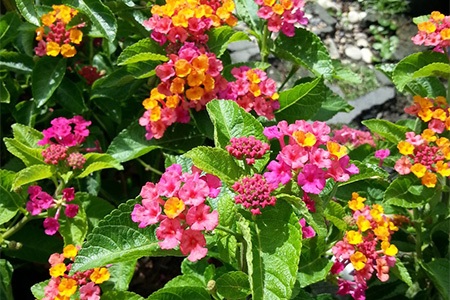
The dwarf lantanas are most commonly seen in patios, window planes, or on small balconies. These are relatively easy to grow and don’t take up much space. Dwarf lantanas are cultivated in small boxes, tubs, and hanging baskets.
The growth of these different lantana plants should not be an issue, because it has a dwarf character and won't grow long or take up much space.
Maintenance is not that complicated, it's just that regular watering will always keep it healthy. Fertilizing every month or two will ensure robust flower blooms.
Lantana Radiation
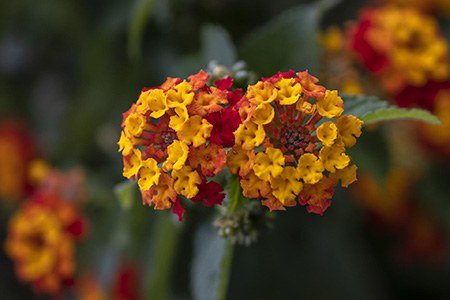
When it comes to border plants, lantana radiation types of lantana flowers steal the show. It is very easy to maintain and grow in a hot climate. It is drought-tolerant, therefore excessive water will not be necessary.
In the growing season, when it's new. It is advised to water the plant regularly to ensure the healthy establishment of roots. Once it is grown, it won't rely on regular watering. Over-fertilizing this lantana is a big no-no because it can rot the roots permanently.
This lantana has sharp spikes on its stem, so before you prune the edges, you better wear protective gloves to be safe.
Lantana Lucky Lavender
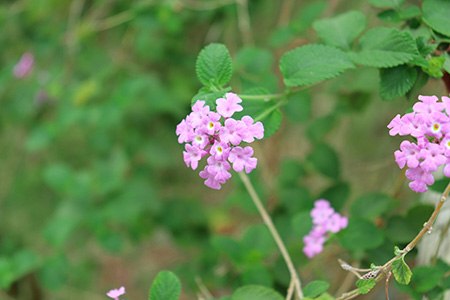
It is a plant that blooms sweet lavender flowers with buttery yellow ones in between. It is a compact plant with a high rate of blooming. These plants can be put in a container or garden set up and it always provides the goods.
Like most lantanas, the lucky lavender is also tolerant to excessive heat and drought. It doesn't produce many berries so the main focus is on creating flowers throughout the season.
For a starting gardener, the lucky lavender is a fine choice. That being said, you are likely to see lavender lantana in most of the landscapes managed by professionals because of its charming colors and desirable qualities.
Pineland Lantana
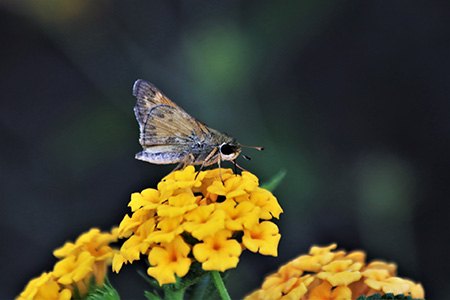
Native to South Florida, the Pineland lantana species has several advantages for your typical flower bed. For one, they don't grow as high, so if you like to keep your beds lower to the ground (like around whatever types of mailboxes you have) then this will work for you.
Another appeal is that these really tend to attract butterflies for whatever reason. Perhaps it's the coloring of bright yellow flowers that makes them think of pollen.
If you want them contained, you'll either want to grow them in a container or maintain them semi-regularly because they're trailing plants that will grow out horizontally over time. That's okay because you can clean them up when you rarely water them thanks to their drought hardy nature.
Whether in landscape islands around trees, around your deck or patio, or even out in the swimming pool area, you'll love having these lantana varieties around.
New Gold Lantana
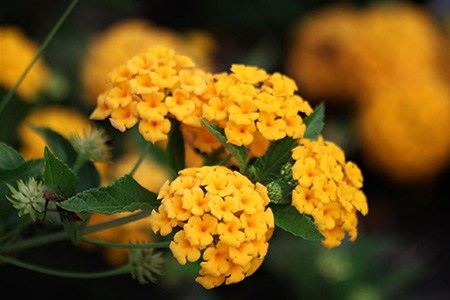
It is a result of hybridizing plants like Montevidensis and Lantana Camara. It has a low mounding stature acting as ground cover. This plant is suited for planting in indoor areas and outdoor gardens or yards.
The new gold lantana is more tolerant to cold temperatures than the other variants we mentioned. The best way to cultivate such a plant is to provide moist soil and let it enjoy full sunlight or partial shade.
The blooming season is an all-year wonder. So it is likely to showboat these types of lantana flowers through and throughout.
Bandana Pink Lantana
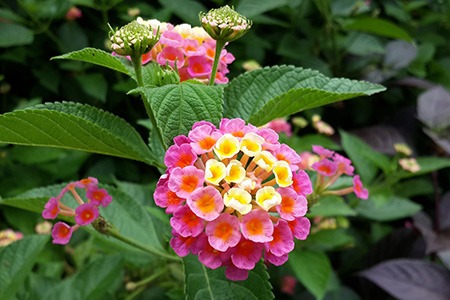
Bandana pink lantana is extremely heat-tolerant and usually find it quite hard to survive adverse weather conditions. This plant produces a vast range of colored flowers from black, brown, blue, yellow, cream, lavender, red, white, and many more shades.
This is a plant that can tolerate extreme humid conditions, thus it is mostly preferred close to pools and hot tubs. With its extensive coverage, this plant also makes a suitable pick for gardening use.
Bandana pink lantanas are known to spread like wildfire. It spreads from the underground stems and eventually covers a large area. To limit the spreading, it is advised to use herbicides.
If it is left to spread freely, it might overshoot the surrounding plants and later make things difficult for you in terms of removal.
Silver Mound Lantana
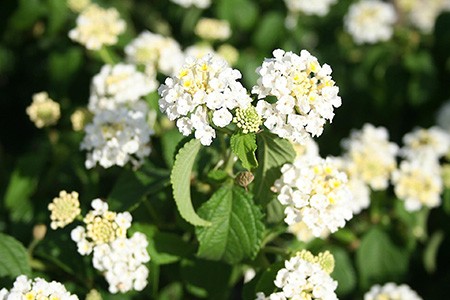
The lantana silver mound starts with a yellowish flower that later changes to white as it matures. It is a year-round blooming plant unless you live in an area where the weather is always frosty. In that chase, it will flourish from spring to fall.
It can tackle excessive heat and long droughts without being impaired. Being extremely attractive, this flowering plant tends to attract hummingbirds, bees, and butterflies.
The best thing is it transforms into an elegant white shade, so you can put it in containers, tubs, or soil beside colorful flowers to make a good contrasty look.
Lantana Camara
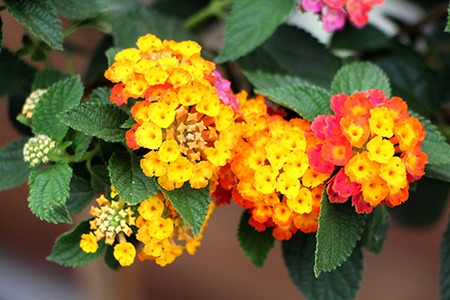
If you want a taller, erect plant that attains some height, look no further than the beautiful Lantana Camara varieties. They'll reach heights as high as ten feet if allowed and do so in an arching form, or a half-sphere shape.
You may want to thin them out over time as they become pretty dense due to the many branches that grow out of the trunk, which then spawn into several branches each. It's a scandent shrub, meaning it has a climbing habit. It'll grow vines out onto other plants, so watch out for that if you care.
You'll enjoy the various colors it can produce, from purple to pink, yellow, white, and red flowers. You'll find it naturally in savannas, pastures, edges of forests, and along disturbed land like fence lines. I've seen them planted along side purple types of violets and it was absolutely stunning.
Purple Trailing Lantana
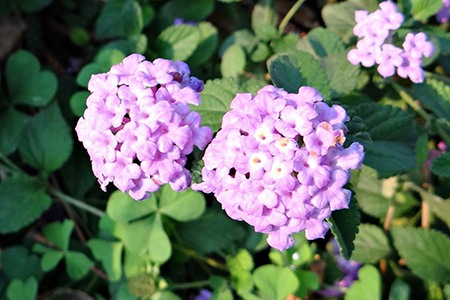
Purple Trailing lantana species are low maintenance and low height, but beware that it's a spreading shrub so you'll have to keep an eye on it to maintain your flower bed. It'll grow about 1 foot to one and a half feet high but can quickly spread to five to 10 feet across.
The dark green leaves, that look a lot like mint, make a great background for the bright purple flowers that will have specks of white on the inside. You'll enjoy the flowers between summer and fall, but may seem them produce at other times of the year if the weather conditions are right.
More Types of Lantana
Of course there are other types of lantana flowers you can get your hands on, but we can't share them all with images and descriptions. But below I'll list out some more so you can continue your exploration:
- Belle Starr Gold Lantana
- Popcorn Lantana
- Red Spread Lantana
- Athens Rose Lantana
- White Trailing Lantana
- Cherry Bandana Lantana
- Three Leaf Lantana
- Spreading Sunset Lantana
- Mango Lantana
- Miss Huff Lantana
- Little Lucky Peach Glow Lantana
You can probably discover more lantana species with some searching but that doesn't mean you'll be able to get ahold of them for yourself. Many are private cultivars that won't be available near you. Remember that it's a noxious plant and that the New South Wales government in Australia has deemed lantana invasion and spread as a key threatening process (KTP).
Types of Lantana to Splash Color in Your Flower Beds
All lantana varieties are extremely durable plants with striking color pallets and functionality to survive in tough conditions. Why wait anymore? You know the common categories, now it's time to fluoresce one or two in your landscape plans.
So, that was pretty much it about some of the different types of lantana flowers available for your gardening needs. Pick out any species you think will embellish your garden the right way, you won't be disappointed.



